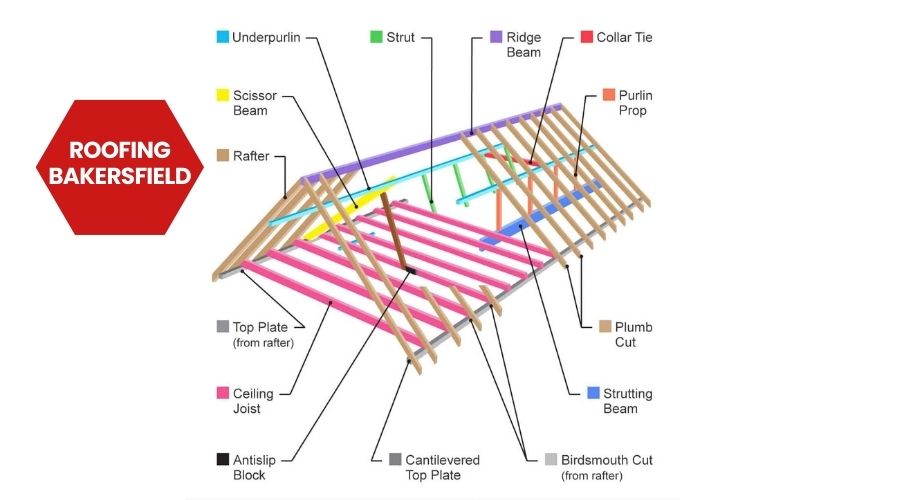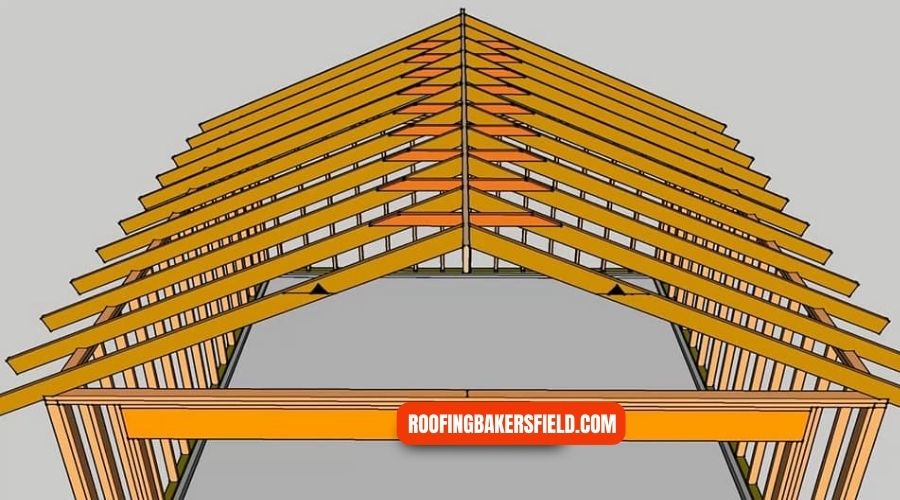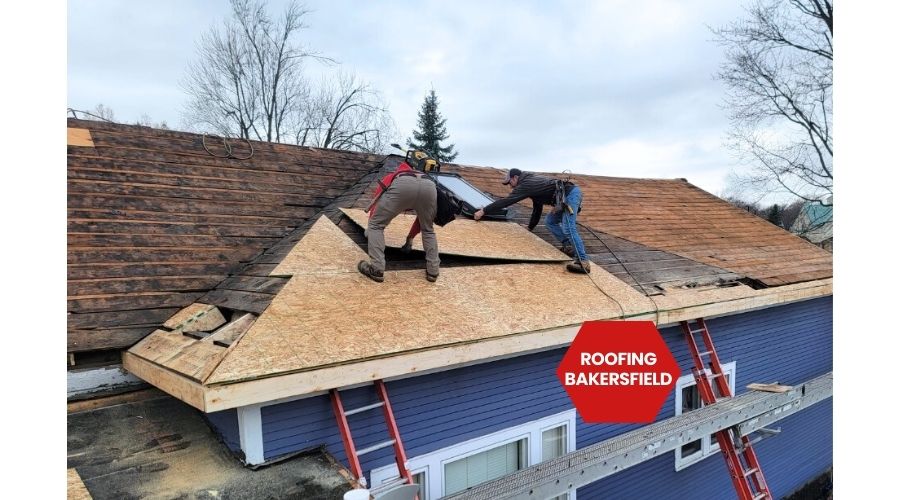Different Parts of a Roof
Ah, the roof, that noble guardian of our homes, standing tall against the onslaught of rain, wind, and whatever else the weather deigns to throw at it. It’s easy to take our roofs for granted, but behind that simple facade lies a world of complexity. So, dear reader, whether you’re a seasoned roofing aficionado or just someone who’s curious about what lies above, buckle up as we take a deep dive into the Parts of a Roof.
Table of Contents

We’ll be your guides on this journey through the shingles and rafters, the flashing and vents. By the time we’re done, you’ll be able to impress your friends at parties with your newfound knowledge of roofing terminology. So, let’s ascend to new heights as we explore the parts of a roof like never before.P
Parts of a Roof Structure
Welcome to the backbone of your house roof, the structural masterpiece that keeps everything in place like a well-choreographed dance routine. Just like how every superhero needs a solid origin story, every roof needs a sturdy structure to stand the test of time.
So, what exactly makes up this formidable fortress of protection as Parts of a Roof diagram? Let’s break it down, shall we?
1. Rafter Raiders
First up, we have the trusty rafters. Think of these as the backbone Part of a Roof, running from the peak down to the eaves like the sturdy spine of a book. They provide the framework upon which the rest of the roof is built, ensuring everything stays in its rightful place.
2. Truss Triumphs
Next, we have the trusses, those ingenious triangular structures that provide additional support and distribute the weight of the roof evenly. It’s like having a team of superheroes working together to shoulder the burden and keep your roof standing tall.
3. Sheathing
It’s time to talk about sheathing being as a Part of a Roof. This is the sturdy layer of material that covers the rafters and trusses, adding an extra layer of protection against the elements. It’s like the armor that shields your roof for roofing services from the slings and arrows of outrageous weather.
4. Underlayment Underdogs
Last but not least, we have the underlayment, the unsung hero of the roofing world. This waterproof barrier sits between the sheathing and the shingles, preventing water from seeping into your home like a trusty guard dog standing watch.
Together, these components form the solid foundation upon which your roof rests, providing the protection and peace of mind you need to weather any storm. So, the next time you look up at your roof, take a moment to appreciate the intricate structure that keeps you safe and sound, high above the chaos below.
Roofing Materials - Parts of a Roof Frame

Ah, roofing materials we as Roofing Company in Bakersfield think the paint on the canvas, the icing on the cake, the… well, you get the idea. Your choice of roofing material – Parts of a Roof Frame can make all the difference when it comes to durability, aesthetics, and even energy efficiency.
Terminology Parts of a Roof – Shingles
First up, we have the tried-and-true champion of the roofing world: shingles. These little guys have been covering roofs for centuries, and for good reason. They’re durable, versatile, and come in a wide range of colors and styles to suit any taste. Plus, they’re relatively easy to install, making them a favorite among DIY enthusiasts and professional roofers alike.
But not all shingles are created equal. You’ve got your asphalt shingles, which are affordable and easy to maintain, but may not last as long as their more expensive counterparts. Then there are cedar shingles, prized for their natural beauty and longevity, but they’ll cost you a pretty penny upfront. And let’s not forget about slate shingles, the Cadillac of roofing materials, known for their unparalleled durability and timeless elegance.
Modern Marvels: Parts of a Metal Roofing
Next on our list, we have metal roofing, the sleek and stylish newcomer to the roofing scene. Metal roofs have come a long way from their humble beginnings as corrugated tin sheets on barns and sheds. Today, they’re available in a variety of materials, including steel, aluminum, and copper, each with its own unique set of benefits.
Metal roofs are incredibly durable, able to withstand everything from hailstorms to hurricane-force winds with ease. They’re also highly resistant to fire, rot, and insect damage, making them a smart choice for homeowners in areas prone to wildfires or termite infestations.
Framework Components for Building a Strong Roof Frame
Alright, let’s get down to the nitty-gritty—the backbone of your roof, the unsung heroes that hold everything together: the framework components. While they may not be as flashy as the shingles or as sleek as the metal roofing, these structural elements are the real MVPs when it comes to keeping your roof standing tall.
Rafters: The Backbone of the Operation
First up, we have the rafters. Think of these as the backbone of your roof, running from the peak all the way down to the eaves like the sturdy spine of a book. They provide the framework upon which the rest of the roof is built, ensuring everything stays in its rightful place. Without them, your roof would be about as stable as a house of cards in a windstorm.
Trusses: Teamwork Makes the Dream Work
Next, we have the trusses, those ingenious triangular structures that provide additional support and distribute the weight of the roof evenly. It’s like having a team of superheroes working together to shoulder the burden and keep your roof standing tall. Trusses are like the Avengers of the roofing world—strong, dependable, and always ready to save the day.
Sheathing: Wrapping It All Up
Now, let’s talk sheathing. This is the sturdy layer of material that covers the rafters and trusses, adding an extra layer of protection against the elements. It’s like the armor that shields your roof from the slings and arrows of outrageous weather. Without sheathing, your roof would be as vulnerable as a knight without a suit of armor—exposed and defenseless against the forces of nature.
Underlayment
Last but not least, we have the underlayment, the unsung hero of the roofing world. This waterproof barrier sits between the sheathing and the shingles, preventing water from seeping into your home like a trusty guard dog standing watch. It may not get the same attention as the flashy shingles or the sturdy rafters, but without it, your roof would be about as effective as a sieve in a rainstorm.
Terminology Demystified: Understanding Roofing Jargon

Ever feel like you need a dictionary just to understand what your roofer company is talking about? You’re not alone. The world of roofing services is rife with jargon and technical terms that can leave even the most seasoned homeowner scratching their head in confusion.
Fascia: The Finishing Touch
Let’s start with fascia. This is the vertical band that runs along the edge of the roof, providing a clean, finished look to the structure. Think of it as the icing on the cake, the cherry on top, the… well, you get the idea. Fascia not only adds aesthetic appeal to your roof but also serves a practical purpose by protecting the edge of the roof from water damage and decay.
Flashing: Keeping Things Watertight
Next up, we have flashing, the unsung hero of the roofing world by Roofing Companies in Bakersfield. This thin, metal strip is installed around roof openings, such as chimneys, skylights, and vents, to prevent water from seeping into your home like an uninvited houseguest. It’s like the sealant that keeps your roof watertight and your interior dry and cozy, even during the fiercest of storms.
Soffit: Ventilation Station
Moving on to soffit, the often-overlooked component of the roof’s anatomy. This is the underside of the eaves, where the rafters extend beyond the walls of the house. Soffit serves a dual purpose, providing ventilation to the attic space while also adding a decorative touch to the exterior of the home. It’s like the lungs of your roof, allowing air to flow freely and keeping your attic space cool and dry.
Ridge: Reaching New Heights
Last but not least, we have the ridge, the highest point of the roof where two sloping sides meet. It’s like the summit of a mountain, the pinnacle of your roof’s journey skyward. The ridge serves as a focal point of the roof’s design while also providing ventilation to the attic space below. It’s where form meets function in perfect harmony, creating a visual and practical centerpiece for your home.
The next time your roofer starts throwing around terms like fascia, flashing, soffit, and ridge, you’ll be armed with the knowledge to nod knowingly and impress your friends with your newfound roofing expertise.
Exploring Specialized Components: Vents, Flashing, and More
Now lets move for roofing components detailed guide from Roofing Bakersfield, CA, where vents whistle, flashing gleams, and every detail plays a crucial role in keeping your roof in top shape. While these elements may not be as prominent as the shingles or as integral as the framework, they are the unsung heroes that work tirelessly behind the scenes to ensure your roof remains sturdy, watertight, and well-ventilated. So, let’s roll up our sleeves and dive into the fascinating world of vents, flashing, and more.
Vents: Letting Off Steam
First up, we have vents—the silent guardians of attic ventilation. These humble fixtures may not look like much from the outside, but inside, they’re hard at work ensuring proper airflow through your attic space. Whether it’s ridge vents, gable vents, or soffit vents, these openings allow warm, moist air to escape from your attic, preventing moisture buildup, mold growth, and premature roof deterioration. These are common Parts of a House Roof. It’s like giving your roof a breath of fresh air, ensuring it stays cool, dry, and healthy year-round.
Drip Edge: Keeping Water in Line
Moving on to another essential component: the drip edge. This unassuming piece of metal may not get much attention, but it plays a crucial role in directing water away from the edges of your roof. Installed along the eaves and rakes, the drip edge prevents water from seeping under the roofing materials and causing damage to the underlying structure. It’s like the gutter’s trusty sidekick, ensuring water flows smoothly off your roof and away from your home’s foundation. So, while it may not be the flashiest component of your roof, the drip edge is definitely one you’ll want to keep an eye on.
Chimney Caps: Keeping Critters Out
Last but not least, we have chimney caps—the unsung heroes of rooftop wildlife control. These metal covers sit atop your chimney, preventing birds, squirrels, and other critters from making themselves at home in your flue. But chimney caps do more than just keep unwanted guests out—they also help protect your chimney from moisture damage, prevent downdrafts, and reduce the risk of chimney fires. So, if you’ve ever wondered why your chimney needs a cap, now you know—it’s not just for looks, it’s for the safety and security of your home.

FAQ's
about
the Different Parts of a Roof
The cost of a new roof system typically falls between $3,000 and $21,500, with an average cost of $14,500. However, it’s important to note that roofing services costs can vary significantly depending on factors such as geographical location and the chosen Roofing Company in Bakersfield, CA. Roofing Contractors take into account various elements including size, materials, structural considerations, the presence of features like chimneys.
Regular maintenance tasks for prolonging the lifespan of your roof include cleaning gutters, inspecting for damage or signs of wear, replacing damaged shingles or flashing, trimming overhanging branches, and ensuring proper attic ventilation. Additionally, scheduling professional roof inspections and maintenance annually by Roofing Companies or Contractors can help catch potential issues early and prevent costly repairs down the line.
When choosing roofing materials, it’s essential to consider several factors beyond mere aesthetics. To ensure the longevity and functionality of your new house roof, take into account the following considerations:
- Consider your climate, as different materials perform better in varying weather conditions.
- Take into account your roof’s design and slope to ensure compatibility.
- Choose materials that enhance your home’s aesthetic appeal and complement its style and color scheme.
The primary components of a roof include the framework (rafters and trusses), roofing materials (shingles, metal, etc.), flashing, vents, sheathing, underlayment, and specialized components such as drip edges and chimney caps.
A deteriorating roof can lead to issues like leaks and mold growth, while a well-maintained roof offers protection and comfort. If you notice signs of failure such as drafts, leaks, or water stains, it’s advisable to seek assistance from a local roofing professional (Apex Roofing Bakersfield, CA). They can assess the condition of your roof, identify the problematic areas, and devise a plan for necessary repairs or replacements.
You can identify different Parts of a Roof by visually inspecting your property from the ground or by climbing onto the roof if it’s safe to do so. Look for features such as rafters, shingles, vents, flashing, and other components mentioned in this guide.
A common question: what are the parts of a roof called or – The Parts of a Roof typically include:
- Roof Deck: The structural base that supports the roofing materials.
- Underlayment: A protective layer installed on top of the roof deck to provide an additional barrier against water penetration.
- Roofing Material: The outer layer of the roof, such as shingles, tiles, metal panels, or roofing membranes, which provide weather protection.
- Flashing: Metal strips or panels installed at roof joints and intersections to prevent water from seeping into vulnerable areas.
- Eaves: The lower edges of the roof that overhang beyond the walls of the building.
- Ridge: The highest point where two roof slopes meet, often covered with ridge caps or vents.
- Fascia: Vertical boards attached to the ends of the rafters, providing a finished appearance and supporting the gutters.
- Soffit: The underside of the eaves, enclosed by the fascia, often ventilated to promote airflow.
- Rafters/Trusses: Structural components that support the roof deck and transfer the weight of the roof to the walls of the building.
- Gutters and Downspouts: Channels and pipes designed to collect and redirect rainwater away from the roof and foundation of the building.
- Ventilation: Intake and exhaust systems installed in the attic or roof to regulate temperature and moisture levels, promoting air circulation and preventing condensation.
